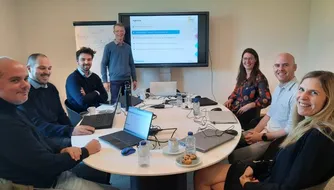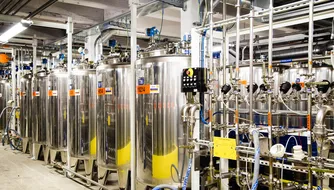Spaas
Spaas streamlines its planning process with Xeleos Consulting

For Spaas, a solid Sales & Operations Planning is a must to master the combination of strong seasonality and capacity constraints. To set up that process, the well-known candle manufacturer enlisted the help of Xeleos Consulting. “Not only did they provide us with Optimact as supporting software. Even more important for us was that we could count on the
necessary expertise to improve our planning,” says Supply Chain Manager Pieter Van Aelst.
Who is Spaas?
Spaas has two manufacturing sites: in Hamont-Achel in Limburg the focus is on highly automated manufacturing, whereas in Poland products are made that require more manual work. All products come together in the distribution centre of the logistics service provider in Lommel, from where they go to the various retailers. Pieter Van Aelst: “We have grown from a local candle manufacturer into a global player. Retailers see us as a reliable partner, both regarding our own brand and the private label market.”
Burning bottlenecks
Spaas’ business is characterized by the enormous seasonality. Half of the annual turnover is realised in the winter period, from October to February. “Therefore, our production sites have a surplus of capacity in summer and too little capacity to meet last-minute customer demand. That is why we have to build up stock several months before our high season starts,” Pieter Van Aelst explains. “An extra challenge is that candles are very trend sensitive. Every six months, a large part of our range is replaced with new scents and colours. In summer, for example, we mainly sell fresh and floral scents, whereas in winter these are rather warm scents, such as vanilla and chocolate. In addition, the number of SKUs is constantly expanding. While we had some 1000 SKUs a couple of years ago, we now have about 2500.” In order to increase its efficiency, Spaas looked for a solution to improve the forecast in the first place. Initially, the account managers entered their forecast themselves in a customised application within SAP. However, this was a time-consuming process and the forecast accuracy left much to be desired.
P. Van Aelst: “During our search we initially came across software vendors who provided pure forecasting tools. We soon realized that those solutions did not offer what we really needed. Not only did we have to tackle the forecasting process itself, but all related processes as well. In particular, good phasing in and phasing out is essential to keep the range rotating smoothly. If we didn’t, we would definitely end up with a lot of slow-moving and even obsolete stock. Besides, we wanted to be able to make better long-term planning and reliable budget exercises.”
S&OP is the answer
Conclusion: rather than a tool, Spaas needed a solid S&OP process to tackle the various planning issues. “When we got in touch with Xeleos Consulting, we soon felt that we had found the right partner,” Pieter Van Aelst says. “They shared our opinion that we should tackle our processes in the first place.” In any S&OP process it is essential that all noses point in the same direction. “The fact that an external partner scrutinised our processes already helped to get the necessary buy-in for S&OP internally. Xeleos Consulting also helped to get everyone on the same wavelength. Everyone
used to work on their own island. It was important to realize that we all had the same goal.” The joint efforts have resulted in an S&OP process with a monthly cycle consisting of several meetings.
P. Van Aelst: “Xeleos Consulting has helped to structure those meetings, so that we can get as much added value as possible from the new, process-based way of working. In the meantime, they have also integrated Qlikview as a reporting tool within Optimact. This ensures that meetings are now organised even more efficiently.” The upcoming products are reviewed during the first meeting. This gives Spaas an overview of the products that will be released in six to nine months time. The expected volumes and the required capacity are discussed. This is followed by a commercial meeting, in which Spaas checks the forecast against the actual sales figures. The causes for any deviating figures are examined and adjusted where necessary. The data from those first meetings serves as preparation for the planning meeting, during which it is estimated what impact the expected volumes will have on machine capacity. At that moment, Spaas decides whether it is necessary to build up stock, shift volumes or possibly invest in new machines. This is how Spaas reaches an actionable forecast. If strategic decisions need to be made or if there are major stumbling blocks, these will be addressed during an ad hoc business review meeting at board level.
Optimact as support
To support the process efficiently and to improve the forecast, manual input in SAP was replaced by Xeleos Consulting’s Optimact tool. P. Van Aelst: “It took some time to find the right approach when
this statistical tool was introduced. For example, we started from very general seasonal curves, which we linked to certain types of products. But after a while we found that was not enough. Even within the same type of product there are too many different patterns. This large variation is related to special days of the year, such as Valentine’s Day or Halloween, for example. That is why we made seasonal curves on a more in-depth level. We determined in detail which SKUs could get the same curve and discussed what would happen with exceptions. We learned a lot from the experience Xeleos Consulting has built up in other markets.” Spaas is currently working with Xeleos Consulting to gain even more insight into resales. At the moment, all the figures for those resales are still collected and entered manually, which is a cumbersome process and offers too little added value. Therefore, the intention is to integrate that process in Optimact as well. Then, the data can be captured automatically, in order to make the necessary calculations.
Higher forecast accuracy
One of the challenges during the implementation of Optimact was to guarantee data quality. For instance, item statuses were not always correct in the beginning and the data on peak sales was not always separated from regular sales data. “However, our efforts have paid off and our forecast accuracy has gradually increased”, Pieter Van Aelst says. “Originally it was between thirty and forty
percent, today it is around seventy percent. Optimact has also provided parameters that quickly spot an exceptional demand, for example because a customer sold out of candles of another brand. In this way we can quickly decide to what extent we can and want to meet that demand.” Naturally, the employees had to get used to the new way of working. “Our salespeople had to let go of control of the forecast, as it now lies with the planning department. It is important that they enter the promotions for each customer properly. This requires even better communication with customers. To get the necessary support from the sales department, it was essential that we also had the commercial director on board,” Pieter Van Aelst explains. “In addition, we now demand more discipline from our product developers. Since we schedule phase-ins more tightly, it is important that developers strictly adhere to that schedule as well. As the sales and design departments got to grips with the new way of working and the positive results surfaced, we noticed that we got them more and more on board.” Obviously, Spaas also needs a good forecast in order to keep inventory levels under control. “If our
forecast is systematically above the actual demand, there is a real chance that we will end up with high stocks after the New Year – when demand falls sharply. With Optimact we succeed in keeping
safety stocks within limits. Moreover, customer service is now much higher, as we have more often in stock what the customer is asking for.”
The impact of the corona crisis
Of course, this does not alter the fact that the corona crisis also had an enormous impact on Spaas. P. Van Aelst: “On the one hand, people want to make it more cosy at home, on the other hand
the hoarding behaviour during the first wave played a role. Since we were just starting to build up the stock, this was a major challenge as only a limited number of people could come to work. As soon as that was possible again, we stepped up our efforts. In the end, we achieved revenue growth last year, but the stress on the organisation was enormous.” Another fact is that last year’s figures cannot serve as a reference, given the epidemiological situation. Our expectation is that the history of 2020 will therefore not be able to serve as a basis. The key question is therefore how this year’s forecasts should be calculated. P. Van Aelst: “Together with Xeleos Consulting we look at what we can do best. Do we pretend 2020 has never existed or do we give a twist to the curves? That is why we are having the consultants analysing some sample products in order to make a good choice. Last year was of course exceptional, but this year we want to focus even more on OTIF (on time in full) deliveries. In recent years, we regularly received spontaneous feedback from Xeleos Consulting based on our figures. They often scoff at things that we had not noticed. This allows us to proactively tackle potential problems and continuously improve them. We greatly appreciate such matters within our collaboration.”


